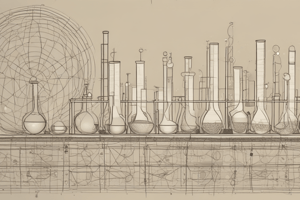Podcast
Questions and Answers
A scientist is studying the effect of fertilizer concentration on plant growth. They prepare four groups of plants, each receiving a different concentration of fertilizer, and measure their heights after two weeks. Which type of graph is most appropriate for presenting this data?
A scientist is studying the effect of fertilizer concentration on plant growth. They prepare four groups of plants, each receiving a different concentration of fertilizer, and measure their heights after two weeks. Which type of graph is most appropriate for presenting this data?
- Pie chart
- Line graph
- Bar chart (correct)
- Flow chart
A research team is investigating the step-by-step process of cellular respiration. Which type of chart would be most effective in illustrating this process?
A research team is investigating the step-by-step process of cellular respiration. Which type of chart would be most effective in illustrating this process?
- Bar chart
- Line graph
- Flow chart (correct)
- Pie chart
In an experiment, researchers found a strong positive correlation between the amount of rainfall and the yield of corn crops. One variable directly impacts the other. In plotting these variables on a line graph, which variable should be placed on the x-axis?
In an experiment, researchers found a strong positive correlation between the amount of rainfall and the yield of corn crops. One variable directly impacts the other. In plotting these variables on a line graph, which variable should be placed on the x-axis?
- Corn yield, as it is the independent variable.
- Rainfall, as it is the dependent variable.
- Rainfall, as it is the independent variable. (correct)
- Corn yield, as it is the dependent variable.
A researcher is analyzing the distribution of blood types in a population. Which type of chart would be most effective for visualizing the percentage of people with each blood type (A, B, AB, O)?
A researcher is analyzing the distribution of blood types in a population. Which type of chart would be most effective for visualizing the percentage of people with each blood type (A, B, AB, O)?
A scientist is conducting an experiment to test a hypothesis. After collecting and evaluating the data, the results contradict the initial hypothesis. What is the next appropriate step in the scientific method?
A scientist is conducting an experiment to test a hypothesis. After collecting and evaluating the data, the results contradict the initial hypothesis. What is the next appropriate step in the scientific method?
Flashcards
Scientific Experiment Steps
Scientific Experiment Steps
A process with steps: observation, hypothesis, experiment (design & conduct), data (collection & evaluation), hypothesis (accept/reject/new).
Line Graph
Line Graph
Compares small changes in a trend over time using numerical data.
Bar Chart
Bar Chart
Compares larger differences in data among groups (numerical & categorical).
Pie Chart
Pie Chart
Signup and view all the flashcards
Flow Chart
Flow Chart
Signup and view all the flashcards
Study Notes
-
Scientific experiments involve six key steps.
-
These steps are: observation, hypothesis formation, experiment design and execution, data collection and evaluation, hypothesis acceptance or rejection, and, if necessary, the creation of a new hypothesis.
-
Data from experiments can be shown in various formats to help researchers analyze data and spot trends.
Graph and Chart Types
- Line graphs are useful for comparing minor changes in a trend over a period.
- They are also useful when comparing numerical data.
- Bar charts are suited to comparing larger changes or differences in data across different groups.
- They are also suited to comparisons of numerical and categorical data.
- Pie charts are used to compare percentages.
- They are also used to compare numerical and categorical data.
- Flow charts show the relationship between concepts or steps in a process.
- They are also used to compare non-numerical data.
Data Analysis
- Each method of data display requires its own analysis technique.
- Line graphs demonstrate relationships between dependent and independent variables.
- They achieve this by plotting coordinate pairs along the x and y-axes.
- The x-axis is horizontal.
- The x-axis plots the independent variable, or the cause.
- The independent variable is not affected by other variables.
- The y-axis is vertical.
- The y-axis plots the dependent variable.
- The dependent variable is affected by the independent variable.
Studying That Suits You
Use AI to generate personalized quizzes and flashcards to suit your learning preferences.




